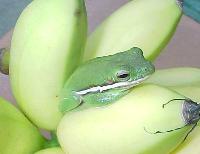
Tree frog
probably Hyla cinerea |
Frogs, Toads,
Tadpoles
and
Your Pond |
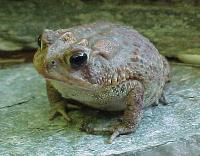
Toad
Probably Bufo terrestris |
By Kit Knotts and Members of
Our Email Discussion List
Click images to enlarge |
|
A welcome sound to most water gardeners is the first frog's
"brrruuup", a sure signal of spring! For us it soon
becomes a symphony of "beepers", tree frogs (probably
Hyla cinerea), and "crooners", leopard frogs
(probably Rana sphenocephala), starting and stopping as
if conducted by an unseen maestro. Less welcome is the screeching
of toads during mating season, an incessant high-pitched grinding
whine that can deprive the neighborhood of sleep.
At some point each year, most of us with ponds will find what
appear to be a jillion tadpoles swimming around, and in most
cases this is not a problem. The vigilant will find the eggs
when they are first laid. Frogs lay their eggs in clusters, toads
in strings, making them easy to tell apart. |
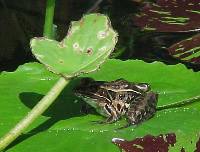
Leopard frog
probably Rana sphenocephala |
Rich Sacher, Louisiana USA
Here in the deep South, we have a common brown toad which is
found even in the center of urban areas. Unlike frogs, which
live in and out of the water all spring and summer, toads are
terrestrial, and only go into the water to mate and lay eggs. |
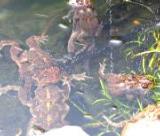
Toads mating
Photo by Lou Ann Norman |
The small black tadpoles of this brown toad secrete a mild toxin.which
is why fish will not eat them. If 8-10 pairs of toads lay thousands
of eggs in a relatively small pond, within a few days of the
eggs hatching, your fish will show signs of stress...and if there
are enough tadpoles, all your fish will die. It happens quite
often here in New Orleans when hobbyists do not know about the
toxicity of toad tadpoles. |
|
The solution is to remove most the eggs every morning after the
previous night's festivities...or to net out lots of tadpoles
every day. A partial water change can also help reduce the level
of toxins in the water, being careful to dechlorinate the fresh
tap water as you add it. A hundred toad tadpoles will not hurt
anything, but thousands of these tadpoles in a small pond can
be toadily tragic. |
Though most frog tadpoles are harmless and even desirable
in the pond, we have heard reports of several types that will
skeletonize waterlily pads.
|
Pablo Maccor, Argentina
I've had tadpoles that eat water lilies. They would eat everything
as long as it was small and tender near the crown -- leaves,
stalks and buds. I believe they are frogs' tadpoles of the Scinax
(Ololygon) genus. I've had Nymphaea 'Virginalis',
'Joey Tomocik', 'Barbara Dobbins' and 'Wood's Blue Goddess' in
the same pond and they would feast on the hardies but would not
touch the tropical. They would also eat Egeria densa,
but would not eat Vallisneria spiralis and Ceratophyllum
demersum. |
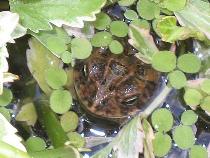
Favorite Frog
Photo by Dennis Melcher |
For many of us, our frogs become almost pets, some even named.
We asked our discussion list members to send us their favorite
frog photos (or their favorite frog's photo) for this gallery.
Favorite Frogs
An excellent web site for the classification, images and sounds
of frogs and toads --
The University of Michigan Museum
of Zoology Animal Diversity Web
Order Anura (frogs and toads)
|




